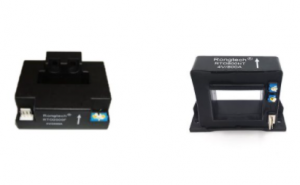Open loop current sensors are essential components in various industrial applications, providing accurate current measurements. To ensure optimal performance, several design considerations must be taken into account. In this technical article, we will highlight key design considerations, including PCB layout, noise reduction techniques, and electromagnetic compatibility (EMC).
1. PCB Layout: Proper PCB layout is crucial for the optimal performance of open loop current sensors. It is important to minimize the length and impedance of current-carrying traces to reduce parasitic resistance and inductance. Placing the sensor close to the current-carrying conductor and minimizing the loop area between the sensor and the conductor can help minimize noise and improve accuracy. Additionally, careful placement of decoupling capacitors near the sensor can help suppress high-frequency noise and maintain stable voltage supply.

Open Loop Current Sensors
2. Noise Reduction Techniques:Open loop current sensors are susceptible to various sources of noise, which can degrade measurement accuracy. Implementing noise reduction techniques is essential to mitigate these effects. Shielding the sensor and its associated electronics from external electromagnetic interference (EMI) can be achieved using grounded metal shields or conductive enclosures. Filtering techniques, such as low-pass filters or ferrite beads, can be employed to suppress high-frequency noise. Careful attention should also be given to the sensor’s power supply, ensuring it is clean and free from voltage ripples or transients.
3. Electromagnetic Compatibility (EMC): EMC is critical to ensure that open loop current sensors operate reliably in the presence of electromagnetic disturbances. Compliance with EMC standards is essential, and design techniques should be implemented to minimize emissions and susceptibility. Grounding and shielding techniques mentioned earlier aid in reducing electromagnetic interference. Proper grounding of the sensor, as well as the surrounding circuitry, helps prevent ground loops and reduces common-mode noise. Additionally, using high-quality components and following best practices for signal routing and isolation can enhance the EMC performance of open loop current sensors.
To gain further insights into the design considerations for open loop current sensors, refer to the following sources:
- 1. “Design Considerations for Open-Loop Current Sensors” – TDK [Link](https://product.tdk.com/en/power/current-sensor/design/consideration/index.html)
2. “Design Considerations for Current Sensing” – Allegro MicroSystems [Link](https://www.allegromicro.com/en/insights/design-considerations-for-current-sensing)
3. “Design Considerations for Open Loop Hall Effect Current Sensors” – LEM International [Link](https://www.lem.com/sites/default/files/2019-12/Design_Considerations_for_Open_Loop_Hall_Effect_Current_Sensors_Paper.pdf)
4. “Design Considerations for Current Sensors” – Analog Devices, Inc. [Link](https://www.analog.com/en/analog-dialogue/raqs/raq-issue-121.html)
In conclusion, optimizing the design of open loop current sensors involves careful consideration of PCB layout, noise reduction techniques, and electromagnetic compatibility. By minimizing parasitic effects, reducing noise sources, and ensuring EMC compliance, designers can achieve optimal performance and accuracy in current measurement applications.
Note: The above sources are provided as reference materials for further reading and are not affiliated with OpenAI.
 rongtech
rongtech






您好!Please sign in